|
|
| |
|
|
| |
Arbiter Fuzz Face
Welcome to a legend. The Dallas-Arbiter Fuzz Face has been around since 1966, and it shows no
signs of dying any time soon. Through this design's past you'll find all kinds of different variations in the basic
original circuit, from PNP Germanium to NPN Silicon, and a countless number of fuzz pedals that are based on it.
One of the most notable Fuzz Face-based distortion pedals is my personal favorite...the Sola Sound ToneBender MKII.
The Fuzz Face has been played by almost every famous guitar player that has ever lived, and this trend will most
likely continue for a very long time to come.
|
I think that this pedal's longevity is due in part to its very simple design. There are four
resistors, three capacitors, two potentiometers, and two transistors...that's it. The original resistors were
1/2-watt carbon-composition with a tolerance of ±10%. The input capacitor was a 2.2µF electrolytic axial lead. The
capacitor from the wiper lug of the fuzz pot to ground was a 20µF electrolytic with axial leads. The 0.01µF capacitor
that connected to the third lug of the volume pot was metallized polyester. The original versions of the Fuzz Face
were equipped with PNP Germanium transistors. There were at least three types used: NKT275, AC128, and SFT363E. These
three transistors are quite hard to come by these days. Beware of modern-day reproductions of the AC128 and NKT275.
As for the SFT363E...I've never even seen one! The circuit board below has NKT275 transistors.
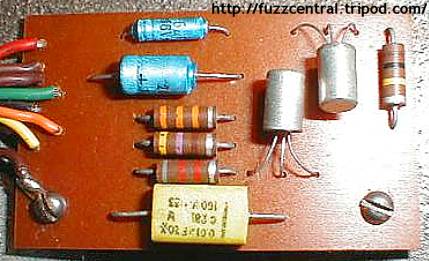
Here's a schematic of the original Germanium transistor version of the Dallas-Arbiter Fuzz Face:

|
As time wore on, Germanium transistors were slowly being phased out in favor of the more stable
and consistent Silicon versions. As a result, Dallas-Arbiter began equipping the Fuzz Face pedals with these new
transistors with differing results. They do sound different from the original Germanium versions, usually with a more
harsh and aggressive clipping as opposed to the "soft" clipping characteristics of Germanium. There was only one part
that was changed in the circuit other than the transistors. The 470-ohm resistor was replaced with a 330-ohm. Also,
take a look at the picture of the Silicon Fuzz Face circuit board below. Notice that the position of the 33K and the
330 resistors are opposite of what they are in the Germanium version. The 470 was in the center in the previous version,
but now it's moved to the outside next to the 20µF capacitor. The transistors that were used in these versions
included: BC108C, BC183L, BC109, BC109C, and BC209C. Most, if not all, of these transistors are still being produced
and are readily available. A while back I ordered some BC108 and BC109C from Futurlec, but I don't recommend them as a
supplier because of their painfully slow shipping. The circuit board below has BC183L transistors, which have the
B-C-E pinout. All the other transistors that were used have the more standard C-B-E pinout, so if you run across a Fuzz Face with
something other than the BC183L, the base and collector leads will be twisted around to work properly.

Here's a schematic of the last of the original Dallas-Arbiter Fuzz Faces, the NPN Silicon:
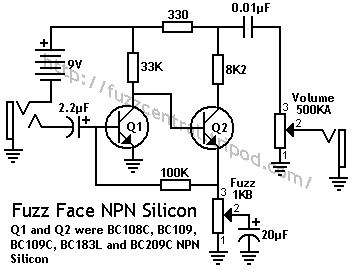
|
In recent years there has been a huge resurgence of interest in the original Arbiter Fuzz Faces, probably
fueled by the very mediocre sounding Dunlop Fuzz Faces. A couple of years back, the Arbiter company made a limited
run of reissue Fuzz Faces, complete with AC128 transistors. If you take a look at the circuit board picture and the
schematic below, you'll see that it's not exactly a reissue, but an improved version of the original. However, all the reissue
circuits aren't the same from unit to unit...there are quite a few variations in the circuit...mostly with the two collector
resistors on the two AC128 Germanium transistors and the output capacitor. Below the circuit board picture you'll see the schematics
of two different variations of the reissue circuit...but there are more!
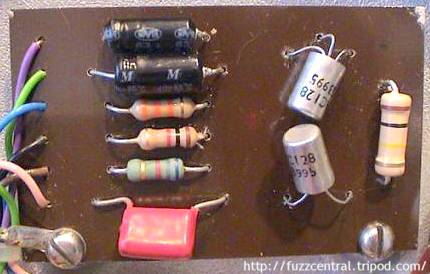
Here's the schematics of a couple of the variations of the Arbiter Fuzz Face Reissue, with changes highlighted in red:
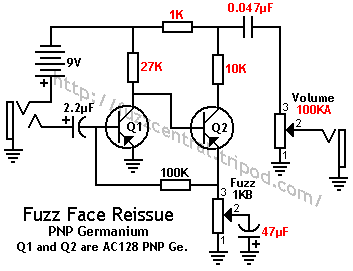 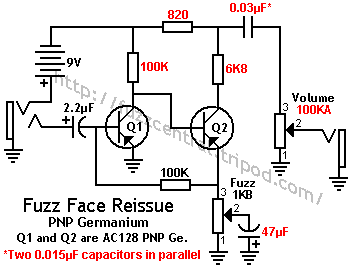
|
It's impossible to draw a conclusion as to which version is "better" than the other, because some
people like the Silicon versions, and some people don't. It is safe to say, however, that the Silicon versions will
obviously be free of one major problem that plagued the Germanium Fuzz Faces...temperature instability. It's been
noted many times over that if they get too hot...they'll stop working. It was also much easier to produce more
consistent sounds from unit to unit with the Silicon versions (whether those "sounds" were good or not was left for
the purchaser of pedal to decide). A problem with Silicon transistors that doesn't seem to exist with Germanium is
that they can have too much gain. Too much gain will cause a Fuzz Face to sound horrid. With Silicon it becomes very
difficult to stick with the Q1 hfe of 70 and Q2 hfe of 120, because most Silicon transistors are way over 120 to
begin with. Someone in Aron's Stompbox Forum said that placing a 100pF capacitor across the Collector-Base junction
of the transistors in a Silicon Fuzz Face clone would help control the gain and oscillation, so if you decide to
build this version, keep that in mind.
|
I personally do not think that wiring up PNP transistors (Silicon or Germanium) as negative ground is
one of the best ideas. The PNP transistors are simply not meant to function with a negative ground and osciallation and
"motorboating" sounds are common results of wiring a Fuzz Face with PNP transistors as such. Here's some more information
from R.G. Keen (GEOFEX):
While in theory, the negative ground conversion for FF and other PNP circuits ought to work every time, there are a
significant number of times where it causes oscillation, motorboating, etc. Sometimes you can clean this up by putting a big
freaking capacitor across the power leads, sometimes you also need a low-impedance 0.1µF ceramic, too, and sometimes you need
divine intervention. Try it if you want, but be aware that there are conditions and layouts that will not be trouble free if
you flip power and ground.
So, in my opinion, I would always leave PNP transistor-equipped circuits as positive ground. A circuit like the Fuzz Face will
use such a small amount of current that a battery will last a very long time, even with heavy use...as long as there's not an LED
to increase current draw. If you're absolutely determined to use a negative ground Fuzz Face, I would suggest that you go through
the extra trouble of getting some NPN Germanium transistors which will work properly with a positive power supply and negative ground.
Small Bear Electronics has NPN Germanium transistors.
|
There has been a lot of controversy about the value of using carbon composition resistors in a
circuit when you're trying to clone the sound of a vintage effect pedal. But for my Fuzz Face clone, I've decided to
build it as accurately as possible, which means using as many NOS parts as I can get my hands on, and when they're
not available, using new production parts that can reproduce the values of the originals. The 1/2-watt carbon comp.
resistors are available from Mouser, although these are 5% tolerance instead of the 10% that the original circuit
used, but this simply means that the value of the resistors will be closer to the desired resistance. I also had
quite a time finding 20µF axial lead electrolytics, but after looking through the Mouser catalog, I discovered that
they do indeed stock 20µF/25V Sprague Atom capacitors, which will be perfect. For the 0.01uF capacitor I'll be using
an original-type flat, metallized polyester film with axial leads. Locating the right transistors for this circuit
could also prove to be a problem, but luckily I have some SK-series Germanium transistors that are just right. I
also soldered a 2M2 input pulldown resistor to the underside of the circuit board to prevent it from popping with
true bypass.
|

|

|

|
Note: These files are NOT to be used in a pedal that you are building for profit. The PCB file is
copyrighted artwork and is subject to a licensing fee.
Dallas-Arbiter Fuzz Face PCB
|
Here
|
Dallas-Arbiter Fuzz Face Layout
|
Here
|
Dallas-Arbiter Fuzz Face Parts List
|
Here
|
Build Difficulty: Easy
|

|
|
The new Fuzz Face PCB and Layout that I have drawn is based on the Axis Face circuit board, which is quite possibly
the smallest and most compact Fuzz Face circuit board available. The layout also uses a 10K trimpot on the collector of Q2 so that that
biasing can be adjusted precisely...around -4.5VDC to -5VDC. It also features a 2.2M input pull-down resistor to prevent "true bypass pop",
a 100uF power supply filtering capacitor and a 1N4001 reverse polarity protection diode to help protect the circuit from accidental reverse
polarity power supply connections. This PCB and Layout can be used to build PNP or NPN transistor versions. Just remember that if you're
building NPN Silicon the 470-ohm resistor should be replaced with a 330-ohm resistor, and you'll have to reverse the polarity of the two
eletrolytic capacitors and it will need to be fed +9VDC instead of -9VDC.
|
|
|
| |
|
|
|

